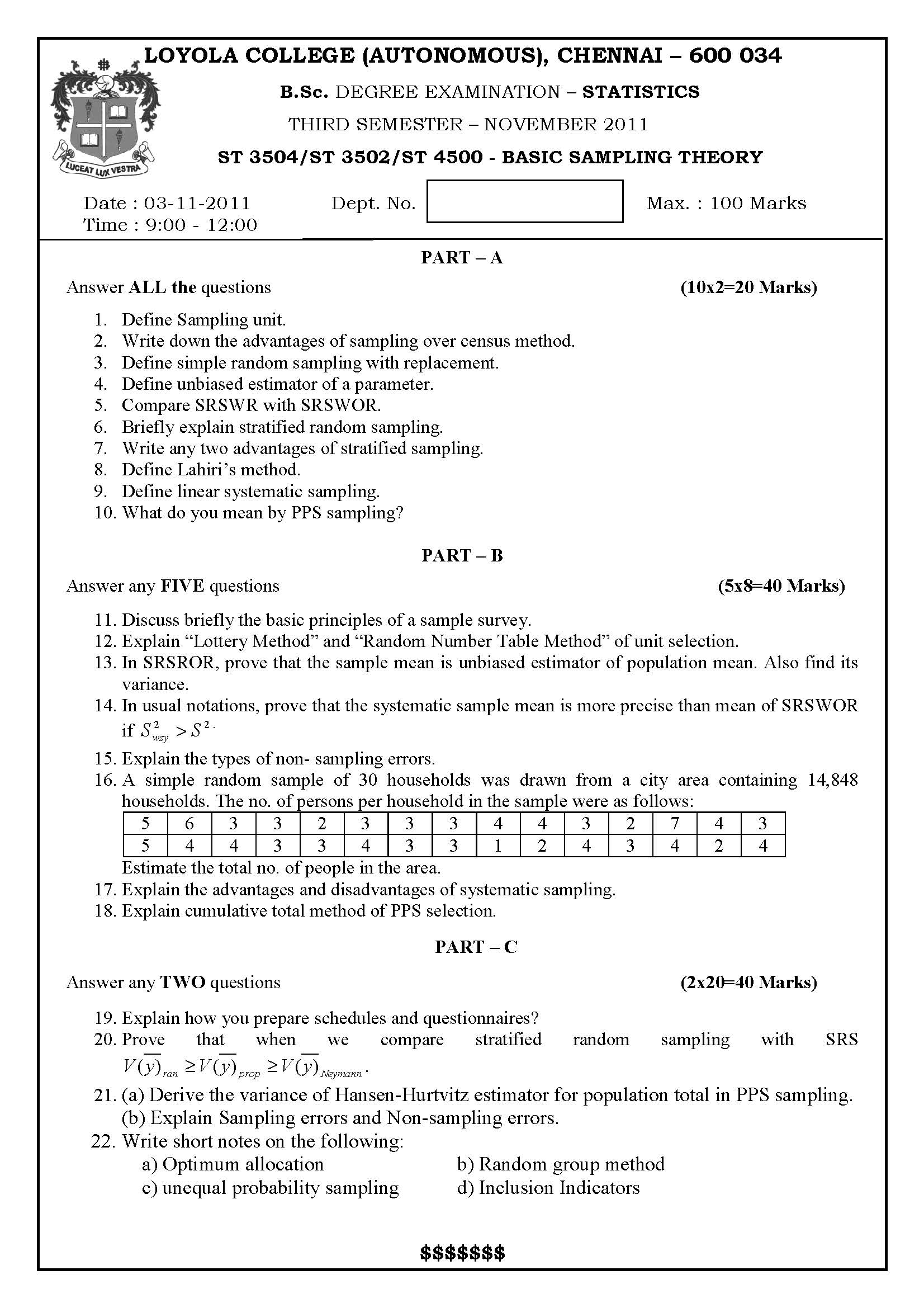LOYOLA COLLEGE (AUTONOMOUS), CHENNAI-600 034.
B.Sc. DEGREE EXAMINATION – STATISTICS
FOURTH SEMESTER – APRIL 2003
ST 4500/ sta 504 BASIC SAMPLING THEORY
11.04.2003
9.00 – 12.00 Max: 100 Marks
SECTION – A (10 ´ 2 = 20 Marks)
Answer ALL the questions. Each carries TWO marks.
- Define a population and mention the assumptions made regarding population size in sampling Theory.
- Explain ‘Sampling frame’ of a population.
- What are the constraints for carrying out a census?
- Distinguish between a statistic and a parameter.
- Derive the expression for the mean square error of an estimator T in estimating q in terms of the variance and bias of the estimator T.
- In SRSWOR, find the probability of selecting rth population unit in ith
- Explain the cumulative total method of selecting a PPS sample.
- Write all possible linear systematic samples of size n = 6 given N = 24.
- Explain stratified random sampling.
- Name any three allocation schemes used in stratified sampling.
SECTION –B (5 ´ 8 = 40 Marks)
Answer any FIVE questions. Each carries EIGHT marks.
- Consider a population containing 4 units with values 7,4,10,5. Two units are drawn one by one without replacement with equal probabilities. Verify whether or not the statistic T =(3y1+ 4y2) /5 is unbiased for the population mean.
- Show that, under usual notations, in SRSWOR
- Show that Lahiri’s method of selection is a PPS selection.
- Examine whether the estimator is unbiased for the population total under PPSWR, where yi is the value of ith drawn unit (i = 1,2,….,n).
- Deduce is SRSWR using expressions for available in PPSWR.
- Letdenote the sample mean of only distinct units under SRSWR.
Find
- Show that in Balanced systematic sampling, the sample mean coincides with
population mean in the presence of linear trend.
- In stratified sampling, under proportional allocation, derive Vand find
an unbiased estimator of V.
SECTION – C (2 ´ 20 = 40 Marks)
Answer any TWO questions. Each carries TWENTY marks.
- (a) Illustrate that an estimator T can become biased under a sampling scheme
even though T is unbiased under another sampling scheme.. (8)
(b) A population contains 5 units and it is known that (12)
Under the usual notations, (i) compare with
(ii) Find the values of a for which is less efficient than.(10)
- (a) consider the following data:
| Plot number | No. of plants | No. of roses |
| 1 | 20 | 56 |
| 2 | 32 | 65 |
| 3 | 14 | 30 |
| 4 | 19 | 47 |
| 5 | 22 | 37 |
| 6 | 7 | 28 |
Assume that a PPSWR sample of size 2 is drawn. Compute Vfor the
data given. Compare it with V. (10)
- Derive an unbiased estimator of Vin PPSWR scheme. (10)
- (a) Describe centered systematic sampling. (5)
- Explain in detail the principal steps involved in the planning and
execution of a sample survey. (15)
- (a) If Co is the overhead cost and Ch is the cost of collecting information per
unit in stratum h, then the total cost of the survey is given by Co+
In optimum allocation, determine the values of n1, n2,……,nL for which
V is minimum subject to a fixed total cost. (12)
- Show that if Yi = a + bi, i =1,2,..,N, then ,
where a stratified sample of size n is drawn as follows:
Divide the population into n groups of k units each. And draw 1 unit from each group where the first stratum contains the first k units, the second
stratum contains the next k units and so on. (8)


